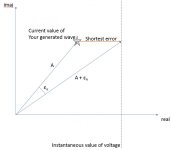naturephoenix
Member
Hello,
I got voltage measurement via AI module. AI module cycle is 50microsec. My PLC cycle is 1ms.
So every 1ms I am getting 20 samples from which I calculate efective value of voltage. Now I need to calculate frequency of my measuring unit (Voltage in this case).
It's generator voltage so basically nominal frequency is gonna be around 50Hz and it's sine wave.
I'm wondering for what kind of methods are the best.
1. First what gets on my mind is zero crossing method. That means every 1ms I'm checking whether
some sample (out of 20 samles) went over zero.
...
Some of the colleagues mentioned to me PLL method, but as far as I can understand this method is used to compare two different frequencies and eventually to make them equal. I don't know how would I use that for my voltage frequency measurement.
Thx in advance.
I got voltage measurement via AI module. AI module cycle is 50microsec. My PLC cycle is 1ms.
So every 1ms I am getting 20 samples from which I calculate efective value of voltage. Now I need to calculate frequency of my measuring unit (Voltage in this case).
It's generator voltage so basically nominal frequency is gonna be around 50Hz and it's sine wave.
I'm wondering for what kind of methods are the best.
1. First what gets on my mind is zero crossing method. That means every 1ms I'm checking whether
some sample (out of 20 samles) went over zero.
...
Some of the colleagues mentioned to me PLL method, but as far as I can understand this method is used to compare two different frequencies and eventually to make them equal. I don't know how would I use that for my voltage frequency measurement.
Thx in advance.









